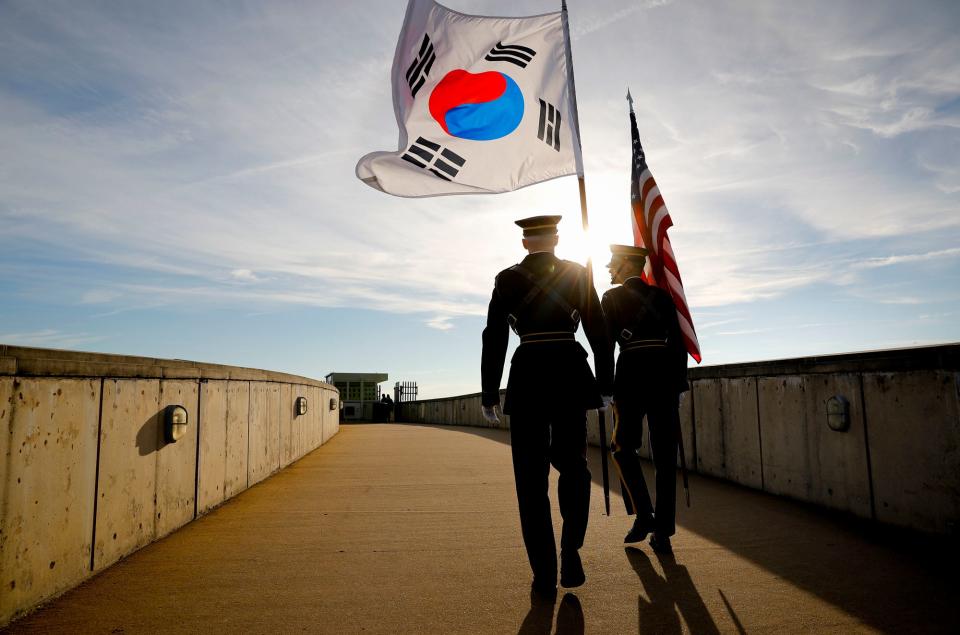What comes next in our turbulent relationship with North Korea?
- Oops!Something went wrong.Please try again later.
- Oops!Something went wrong.Please try again later.
July 27, 2023, marked the 70th anniversary of the armistice ending overt fighting in the Korean conflict, a bloody war with more than 37,000 U.S. soldiers killed over three years and overall casualties, military and civilian, totaling 6 million. Most Americans know little about the war, although we are now witnessing mounting and troubling events involving what is now referred to as North Korea. When did this conflict start, what were some significant turning points, and what is the current outlook for peace?
The war
North Korea invaded what is now called South Korea in June 1950. Control of Seoul, the capital, changed hands five times during that year. The war was almost lost by the U.S. during the first weeks, saved by a last-minute stand at the Pusan peninsula. Later, after what has been characterized as a brilliant tactical invasion at Inchon, orchestrated by Gen. Douglas MacArthur, American troops pushed the North Koreans above the 38th parallel and then onward to the Chinese border. Victory seemed assured.
However, as chronicled by David Halberstam in his classic book “The Coldest Winter,” as brilliant as MacArthur’s invasion at Inchon was, his stubbornness and bravado led to very dark days for American soldiers and their South Korean counterparts.
Despite warnings by U.S. intelligence that Chinese troops were amassed at the border, MacArthur ordered thinly dispersed Marine troops to the Yalu River between North Korea and China. In October 1950, during the Battle of Chosin Reservoir, 270,000 Chinese soldiers crossed the border, repelling American forces and imposing heavy casualties. During the next two months, American troops were pushed back to the 38th parallel.

The 1st Marine Division, although significantly outnumbered and fighting in sub-zero weather, fought its way back. This battle gave rise to the famous Marine Corps words: “Retreat, hell — we are just attacking in another direction.” And survive they did, securing their positions, bringing home their dead, saving their equipment, "retreating" with morale high and killing or wounding 41,000 Chinese troops. As dramatic as the withdrawal was, the Battle of Chosin Reservoir was subsequently seen as a stunning military defeat, and the first from which the U.S. did not recover to win total victory.
Halberstam’s riveting book provides subsequent details, but suffice it to say the following events took place after the Chosin Reservoir battle:
MacArthur was fired by President Harry Truman.
American forces were renewed under the courageous leadership of Gen. Matthew Ridgeway (years later praised by Colin Powell as the man who saved South Korea).
Truce negotiations began in July 1951.
A stalemate in fighting continued along the 38th parallel for two additional years. Finally, negotiations culminated on July 27, 1953, "encouraged" by a threat from President Dwight Eisenhower that he would use nuclear weapons if a truce was not finalized.
More perspective 70 years have passed since Korean cease-fire. It's time to end America's longest war.
The problem that won't go away
And we are here again, but now it is North Korea that is threatening to use nuclear warfare. In an article in The Atlantic titled “The Worse Problems on the Earth,” Mark Bowden suggests that there are no good options for the U.S. regarding North Korea, as he examined four potential approaches: a) prevention, b) decapitation, c) turning the screws, and d) acceptance.
He concluded that none is foolproof or without risks.
Former U.S. Secretary of Defense Robert Gates, in a Wall Street Journal article, echoed the same basic view, arguing that there are simply no good military options, as the sheer destructive potential of an all-out war would be disastrous. Still, he argued that North Korea must freeze its nuclear program and keep delivery systems to short range, but he noted that the U.S. has relatively little military leverage to bring about these outcomes.
In 2019, then-President Donald Trump met with Kim Jong-Un, North Korea’s leader, and, in Trump’s telling, persuaded the dictator to abandon his nuclear program and agree on a non-nuclear future. Instead, North Korea significantly expanded its nuclear capacity. It was really a nonstarter to believe North Korea would ever surrender its nuclear weapons.
In a March 2023 New York Times article, Lt. Gen. Dan Leaf, a former commander of the U.S. Pacific Command, observed that North Korea is conducting missile tests at a record pace, including powerful intercontinental ballistic missiles now capable of delivering 40-plus nuclear warheads anywhere in the continental United States. Furthermore, Leaf contends, North Korean leader Kim has passed a law authorizing a preemptive nuclear strike.
In this hair-trigger environment, Leaf argues that one wrong decision or misunderstanding could result in loss of life for millions. Interestingly, he argues for 1) a formal peace treaty among the U.S., South Korea and North Korea; 2) America to pursue serious and urgent diplomacy with North Korea; 3) the U.S. and North Korea to establish liaison offices in each country; 4) the U.S. to abandon the idea of North Korea's eliminating its nuclear weapons; and 5) the U.S. to assist the North Korean regime to promote human rights and improve health for its citizens.
Outlook
Opportunities have been missed by both sides. The result has been that successive U.S. administrations have been unable to prevent North Korea from becoming one of only three countries in the world that can target the United States with nuclear weapons. Nothing has worked in the past, so perhaps the approach suggested by Leaf is worth consideration. Who knows? Nothing else has been effective.
Richard F. Keevey held two presidential appointments as deputy undersecretary at the Department of Defense and as the CFO at the Department of Housing and Urban Development. He was appointed budget director by two New Jersey governors. He is currently a senior policy fellow at Rutgers University and a visiting lecturer at Princeton University. He served as the executive officer of a nuclear missile battery in Europe in the mid-1960s.

This article originally appeared on NorthJersey.com: North Korea: A brief history and ongoing worries

